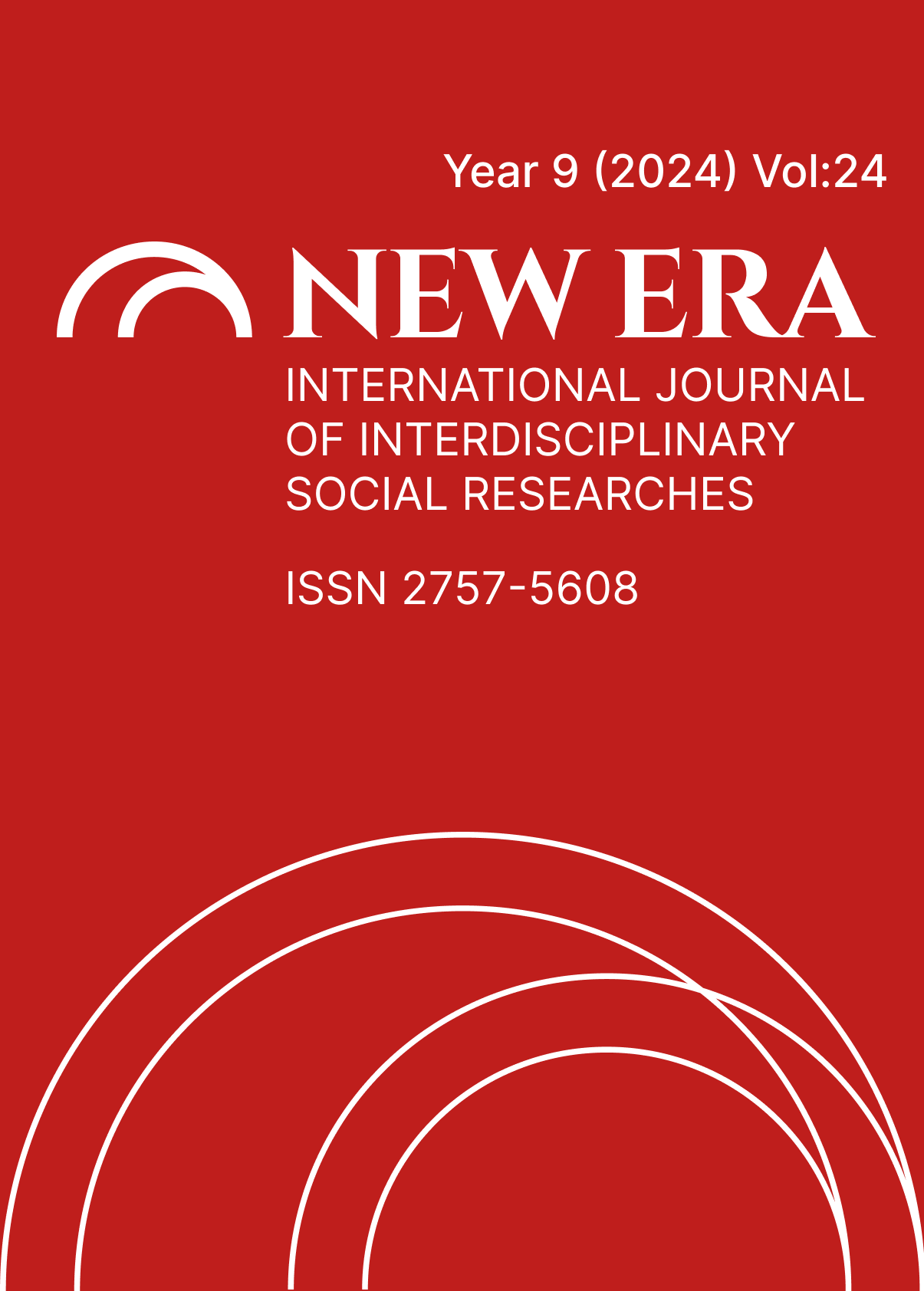PREPOSITIONS IN MEVLÂNÂ SEKKÂKÎ DÎVÂNI
DOI:
https://doi.org/10.5281/zenodo.12534779Keywords:
Çağatay Turkish, Mevlânâ Sekkâkî, Dîvân, Prepositions, RegimentationAbstract
There are many opinions about the definition of prepositions. In general, prepositions are expressed as words that do not have meaning on their own, gain meaning with the words they are used with, have grammatical tasks and have a wide range of uses within word types. Many prepositions have undergone sound and shape changes from historical times to the present. Thus, prepositions have shown themselves by taking on the shape and form characteristics of the period in which they were used. We do not have clear information about Mevlana Sekkâkî. However, it is said that Mevlana Sekkâkî was born in the first half of the XVIth century, may have lived in the second half of the XIV century and the second half of the XV century, may have spent part of his life in Samarkand, and may have died in the first half of the XV century. Mevlânâ Sekkâkî's work that we have is Dîvâni. There are 2 copies of Mevlânâ Sekkâkî Dîvâni. Based on these two copies, Kemal Eraslan created the publication called Mevlânâ Sekkâkî Dîvâni. In Mevlana Sekkâkî's poems, it is possible to see the mazmuns of old Turkish literature, literary arts, verses and hadiths, parables and narrations, important figures in the Eastern and Western worlds, the disruptions and arrangements in the social life of the period, and the Sufi culture. Based on the ghazals and odes of Mevlana Sekkâkî, who stands out with his competence in the style of ode, one of the first representatives of classical Chagatai literature, it is possible to say that he knew the Turkish poetry tradition and the Persian poetry tradition well. In this article, general information about Mevlânâ Sekkâkî and Dîvânî, the most important poet of Classical Chagatai literature, is given. The current views on prepositions have been examined, and it has been tried to clarify how the shape features of the prepositions and prepositional noble words in the work are in Çağatay Turkish. In addition, classifications about the types of prepositions were mentioned and Mustafa Argunşah's classification of prepositions in Çağatay Turkish was taken as a basis. It has been determined how many times which preposition type is used in the work. In the writing of the examples in our study, the spelling of the source was adhered to based on Kemal Eraslan's Mevlânâ Sekkâkî Dîvân publication. While giving the equivalents of the prepositions in Turkey Turkish, it is based on interpretation through the TEBDİZ system. On the basis of Mustafa Argunşah's classification of prepositions in Çağatay Turkish, there are 1196 prepositions and prepositional uses in Mevlânâ Sekkâkî Dîvân. Prepositions are actively used in the work and there are few verses where prepositions are not used.
References
Akın, Lemi. Türkiye Türkçesinde Bağlaçlar. İstanbul Üniversitesi, Sosyal Bilimler Enstitüsü, Yayımlanmamış Yüksek Lisans Tezi, 2004.
Argunşah, Mustafa. Kirdeci Ali Kesikbaş Destanı. Ankara: Kültür Bakanlığı Yayınları, 2002.
Argunşah, Mustafa. Çağatay Türkçesi. İstanbul: Kesit Yayınları, 2013.
Atay, Ayten. Çağatay Türkçesinde Edatlar. Ankara: Çizgi Kitabevi Yayınları, 2018.
Atabay, Neşe. vd. Sözcük Türleri: Ad, Sıfat, Belirteç, Adıl, İlgeç, Bağlaç, Ünlem, Eylem. (Hzl.: Doğan Aksan), Ankara: TDK Yayınları, 1983.
Atabey, İbrahim. “Cümle Bağlayıcıları ve Türkiye Türkçesindeki Kullanımı”. Turcology in Turkey, Selected Papers (Ed.: László Károly), Szeged, (2007), 39-54.
Banguoğlu, Tahsin. Türkçenin Grameri. Ankara: TDK Yayınları, 2004.
Boz, Erdoğan. “Sözlükler İçin Yeni Bir Dilbilgisel Bilgi Önerisi: İlgeçlerin Atadıkları Biçimbirimler”. Uluslararası Türkçe Edebiyat Kültür Eğitim Dergisi. S.2, (2018), 749-758.
Bökö, İbrahim Salih. Ali Şir Nevayi'nin "Garaibü's-Sıgar" İsimli Eserinde Edatlar. İstanbul Üniversitesi, Sosyal Bilimler Enstitüsü, Yüksek Lisans Tezi, 2018.
Demir N. & Yılmaz, E. Türk Dili El Kitabı. Ankara: Grafiker Yayınları, 2014.
Deny, J. Türk Dilbilgisi. (Çev.: A. U. Elöve), İstanbul: Kabalcı Yayınları. 2012.
Dizdaroğlu, H. Tümce Bilgisi. Ankara: TDK Yayınları, 1976.
Doğan, N. “Çok İşlevlilik Açısından Türkçe Edatların Söz Dizimsel ve Anlam Bilimsel Yapısı”. Dil Araştırmaları Dergisi, S.15, (2014), 105-119.
Eckmann, J. “Küçük Çağatay Grameri.” Türk Dili ve Edebiyatı Dergisi, S.10, (2012), 41-64.
Ediskun, H. Türk Dil Bilgisi. İstanbul: Remzi Kitabevi. 1999.
Efendioğlu, S. “Edatların Sınıflandırılması”. Erciyes Dergisi, S.353, (2007), 27-29.
Eraslan, Kemal. Mevlânâ Sekkȃkî Dîvânı. Ankara: TDK Yayınları. 1999.
Ergin, Muharrem. Türk Dil Bilgisi. İstanbul: Bayrak Yayınları, 2006.
Gencan, Tahir Nejat. “Edatlar ve Edat Tümleçleri”. Türk Dili, S.17, (1968), 198.
Gencan, Tahir Nejat. Dil Bilgisi. Ankara: Ayraç Yayınları, 2001.
Hacı, Kutlu. “Cümcümenâme’de Edatlar ve Edat Görevli Sözcükler”. Dede Korkut Uluslararası Türk Dili ve Edebiyatı Araştırmaları Dergisi, S.28, (2022), 65-79.
Karaağaç, Günay. Türkçenin Dil Bilgisi. Ankara: Akçağ Yayınevi. 2016.
Karaağaç, Günay. Dil Bilimi Terimleri Sözlüğü. Ankara: TDK Yayınları. 2018.
Karahan, Leyla. Türkçe Söz Dizimi. Ankara: Akçağ Yayınevi. 1999.
Kılıç, Fatma. “Mevlȃna Sekkȃkî Divanı’nda Geçen Deyimler Üzerine Kavramsal Bir Sınıflandırma Denemesi”. Uluslararası Uygur Araştırmaları Dergisi, S.16, (2020), 83-108.
Korkmaz, Zeynep. Türkiye Türkçesi Grameri. Ankara: TDK Yayınları, 2003.
Pul, Mehmet. Türkiye Türkçesinde Edat. Sakarya Üniversitesi, Sosyal Bilimler Enstitüsü, Yayımlanmamış Yüksek Lisans Tezi, 2002.
Soydan, Serpil. “Karışık Dilli Eserlerin Söz Varlıklarından Edatlara Bir Bakış”. Turkish Studies - International Periodical For The Languages, Literature and History of Turkish or Turkic, Ankara, (2013), 2243-2268.
Soydan Serpil. “Ali Şîr Nevâyî’nin Manzum Eserlerinde dėk / dik Edatının Kullanımı”. Dil Araştırmaları, S.24, (2019), 131 – 147.
Tapık, Hatice. Sekkâki Dîvânı Yapım Ekleri Üzerine Bir Çalışma. Niğde Ömer Halis Demir Üniversitesi, Sosyal Bilimler Enstitüsü, Yüksek Lisans Tezi, 2020.
Vardar, Berke. Açıklamalı Dilbilim Terimleri Sözlüğü. İstanbul: Multilingual, 2002.
İnternet Kaynakları
URL1: https://lehcediz.com/tebdiztest/ (Erişim: 15.11.2023)
URL2: https://islamansiklopedisi.org.tr/sekkaki-ebu-yakub (Erişim: 10.12.2023)
URL3: https://teis.yesevi.edu.tr/ (Erişim: 25.01.2024)
URL4: https://tr.wikipedia.org/wiki/Sekkaki (Erişim: 18.01.2024)
Downloads
Published
How to Cite
Issue
Section
License
Copyright (c) 2024 NEW ERA INTERNATIONAL JOURNAL OF INTERDISCIPLINARY SOCIAL RESEARCHES

This work is licensed under a Creative Commons Attribution-NonCommercial 4.0 International License.


